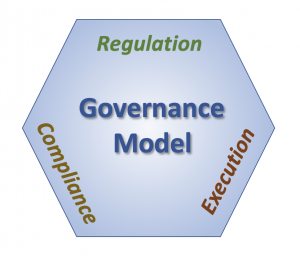User Tools
Sidebar
Add this page to your book
Remove this page from your book
Table of Contents
Appendix J: Governance Model
Fundamental Governance Model
- Note: The following is based on an Engineering Governance Model developed at US Navy SPAWAR1).
Governance is not a synonym for government or for regulations; rather, governance is the process governments use to interpret and use regulations.
- Governance is that separate process or certain part of management or leadership processes that make decisions that define expectations, grant power, or verify performance. Frequently a government is established to administer these processes and systems. 2)
This definition offers three aspects as to what comprises governance:
- Making decisions that define expectations
- Granting power
- Verifying performance
The first aspect of governance conveys regulation, the second aspect conveys execution, and the third aspect conveys compliance, as represented in the following model.
Good governance is comprised of all three components in equal and sometimes opposing aspects. It is meaningless to have regulation without execution or execution without compliance. In other words, regulation indicates what needs to be done, execution is actually doing it, and compliance is making sure it is done correctly.
Regulation
Regulations are formal, codified authoritative rules. They are adopted by a public regulatory agency and are usually interpretations of statutes passed by a legislative body.
A regulation as a legal term is a rule created by an administration or administrative agency or body that interprets the statutes setting out the agency's purpose and powers, or the circumstances of applying the statute. A regulation is a form of secondary legislation which is used to implement a primary piece of legislation appropriately, or to take account of particular circumstances or factors emerging during the gradual implementation of, or during the period of, a primary piece of legislation.3)
An example of the regulatory aspect of governance is a body that creates statutes such as the U.S. Congress or a state legislature, an agency that creates or enforces statutes such as the U.S. Internal Revenue Service (IRS), or civilian or commercial groups that create and promote standards such as the Object Management Group® (OMG®).
Compliance
Compliance ensures that regulations are met through observation, measurement or testing. Good governance cleanly and effectively separates the responsibility for creating regulations from the enforcement of these regulations. This does not mean that regulations can be developed in a vacuum; they must be written to be enforceable using objective measures of compliance. Therefore, the line between regulation and compliance is not fixed and rigid but needs to be negotiated with validation of regulations from the compliance aspect.
Examples of the Compliance Aspect of Governance is the auditing functionality of the IRS and the independent verification and validation (IV&V) functionality within the DoD.
Execution
Execution is the aspect of governance charged with actually fulfilling formal, codified authoritative rules specified by regulation to those specifications provided by compliance. The responsibility for executing the regulation rarely, if ever, falls on the legislative body or those responsible for enforcing compliance with the regulation. Without execution, the other aspects of Governance are meaningless. Consequently, any discussion of governance must include the Execution Aspect.
Examples of the Execution Aspect are the individuals that file their tax forms with the IRS and the personnel who actually create the functionality needed by a DoD Program, Project, or Initiative.





